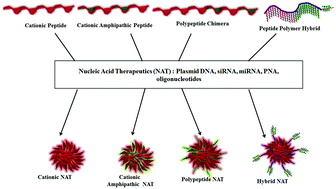当前位置:
X-MOL 学术
›
Biomater. Sci.
›
论文详情
Our official English website, www.x-mol.net, welcomes your feedback! (Note: you will need to create a separate account there.)
Peptides, polypeptides and peptide–polymer hybrids as nucleic acid carriers
Biomaterials Science ( IF 6.6 ) Pub Date : 2017-09-07 00:00:00 , DOI: 10.1039/c7bm00584a Marya Ahmed 1, 2, 3, 4
Biomaterials Science ( IF 6.6 ) Pub Date : 2017-09-07 00:00:00 , DOI: 10.1039/c7bm00584a Marya Ahmed 1, 2, 3, 4
Affiliation

|
Cell penetrating peptides (CPPs), and protein transduction domains (PTDs) of viruses and other natural proteins serve as a template for the development of efficient peptide based gene delivery vectors. PTDs are sequences of acidic or basic amphipathic amino acids, with superior membrane trespassing efficacies. Gene delivery vectors derived from these natural, cationic and cationic amphipathic peptides, however, offer little flexibility in tailoring the physicochemical properties of single chain peptide based systems. Owing to significant advances in the field of peptide chemistry, synthetic mimics of natural peptides are often prepared and have been evaluated for their gene expression, as a function of amino acid functionalities, architecture and net cationic content of peptide chains. Moreover, chimeric single polypeptide chains are prepared by a combination of multiple small natural or synthetic peptides, which imparts distinct physiological properties to peptide based gene delivery therapeutics. In order to obtain multivalency and improve the gene delivery efficacies of low molecular weight cationic peptides, bioactive peptides are often incorporated into a polymeric architecture to obtain novel ‘polymer–peptide hybrids’ with improved gene delivery efficacies. Peptide modified polymers prepared by physical or chemical modifications exhibit enhanced endosomal escape, stimuli responsive degradation and targeting efficacies, as a function of physicochemical and biological activities of peptides attached onto a polymeric scaffold. The focus of this review is to provide comprehensive and step-wise progress in major natural and synthetic peptides, chimeric polypeptides, and peptide–polymer hybrids for nucleic acid delivery applications.
中文翻译:

肽,多肽和肽-聚合物杂合体作为核酸载体
病毒和其他天然蛋白质的细胞穿透肽(CPP)和蛋白质转导域(PTD)充当开发有效的基于肽的基因递送载体的模板。PTD是酸性或碱性两亲性氨基酸序列,具有优异的膜侵入效率。然而,衍生自这些天然,阳离子和阳离子两亲性肽的基因递送载体在调整基于单链肽的系统的物理化学性质方面几乎没有灵活性。由于肽化学领域的显着进步,经常制备天然肽的合成模拟物,并已对它们的基因表达进行了评估,这些模拟物是氨基酸功能,肽链的结构和净阳离子含量的函数。而且,嵌合的单个多肽链是由多个小的天然或合成肽的组合制备的,这些肽赋予基于肽的基因递送治疗剂以独特的生理特性。为了获得多价并改善低分子量阳离子肽的基因传递效率,通常将生物活性肽掺入聚合物结构中,以获得具有改进的基因传递效率的新型“聚合物-肽杂种”。通过物理或化学修饰制备的肽修饰的聚合物表现出增强的内体逃逸,刺激响应性降解和靶向功效,这是附着于聚合物支架上的肽的物理化学和生物学活性的函数。
更新日期:2017-10-24
中文翻译:

肽,多肽和肽-聚合物杂合体作为核酸载体
病毒和其他天然蛋白质的细胞穿透肽(CPP)和蛋白质转导域(PTD)充当开发有效的基于肽的基因递送载体的模板。PTD是酸性或碱性两亲性氨基酸序列,具有优异的膜侵入效率。然而,衍生自这些天然,阳离子和阳离子两亲性肽的基因递送载体在调整基于单链肽的系统的物理化学性质方面几乎没有灵活性。由于肽化学领域的显着进步,经常制备天然肽的合成模拟物,并已对它们的基因表达进行了评估,这些模拟物是氨基酸功能,肽链的结构和净阳离子含量的函数。而且,嵌合的单个多肽链是由多个小的天然或合成肽的组合制备的,这些肽赋予基于肽的基因递送治疗剂以独特的生理特性。为了获得多价并改善低分子量阳离子肽的基因传递效率,通常将生物活性肽掺入聚合物结构中,以获得具有改进的基因传递效率的新型“聚合物-肽杂种”。通过物理或化学修饰制备的肽修饰的聚合物表现出增强的内体逃逸,刺激响应性降解和靶向功效,这是附着于聚合物支架上的肽的物理化学和生物学活性的函数。



























 京公网安备 11010802027423号
京公网安备 11010802027423号